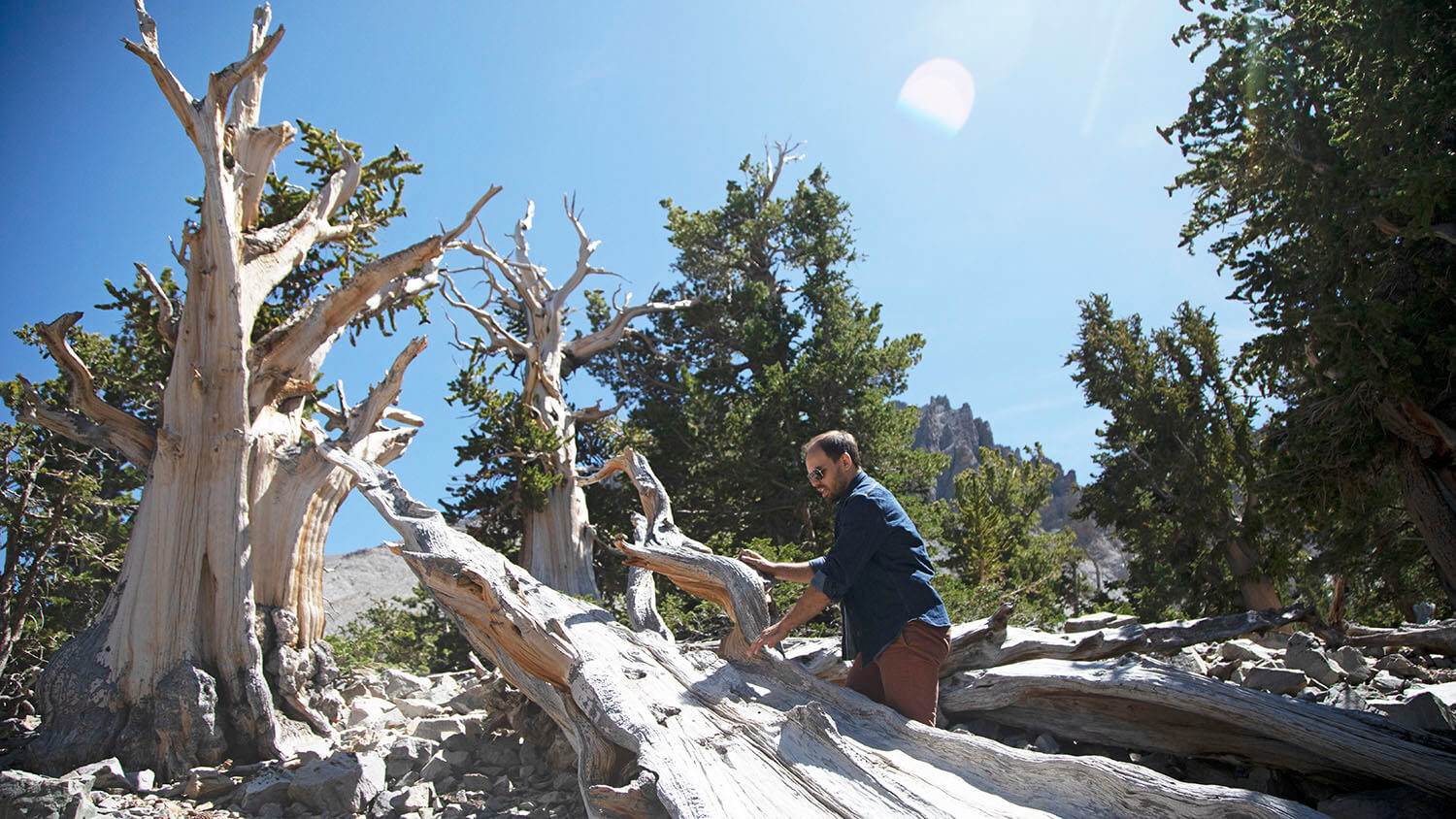At up to (and occasionally more than) 5,000 years of age, most scientists consider the bristlecone pine to be the oldest living organism on Earth. In recent years, there has definitely been some serious scuffle involving certain less “precisely measurable” organisms, like cyanobacteria. However, as our planet’s oldest “non-clonal organism,” it’s at least safe to say the Great Basin bristlecone is the oldest living species of tree. We’ll take it.
Great Basin National ParkDON’T GET IT TWISTED: The Bristlecone Pine is the Gnarliest Tree on Earth
When it comes to attractions, the Silver State is home to all kinds of intriguing blasts from the past—from ghost towns and Wild West saloons to fossils and geological phenomena. But at the top of our list, you’ll find the oldest living things on the planet—the fascinatingly tough, element-defying, Great Basin bristlecone pine trees.
Most of these (literally) gnarly trees have been alive 3,000 to 5,000 years. Imagine them clinging to rocks when the Romans were having their heyday. Yep—bristlecones were already alive by 1,500 years by then. The reign of Cleopatra and the construction of the pyramids? They’d already been growing quietly for 2,000 years. The completion of the Great Wall of China, the development of the printing press, the “discovery” of the New World… the list goes on—these bad boys were already twisting their way skyward when all those things happened. And today, you can walk right up to them on the slopes at what is now Great Basin National Park.
Looking to branch out into new travel turf? Peruse this lineup of fun facts, tips, and history; then come get face-to-face with some funky flora that was flourishing at least a few thousand years before you were.
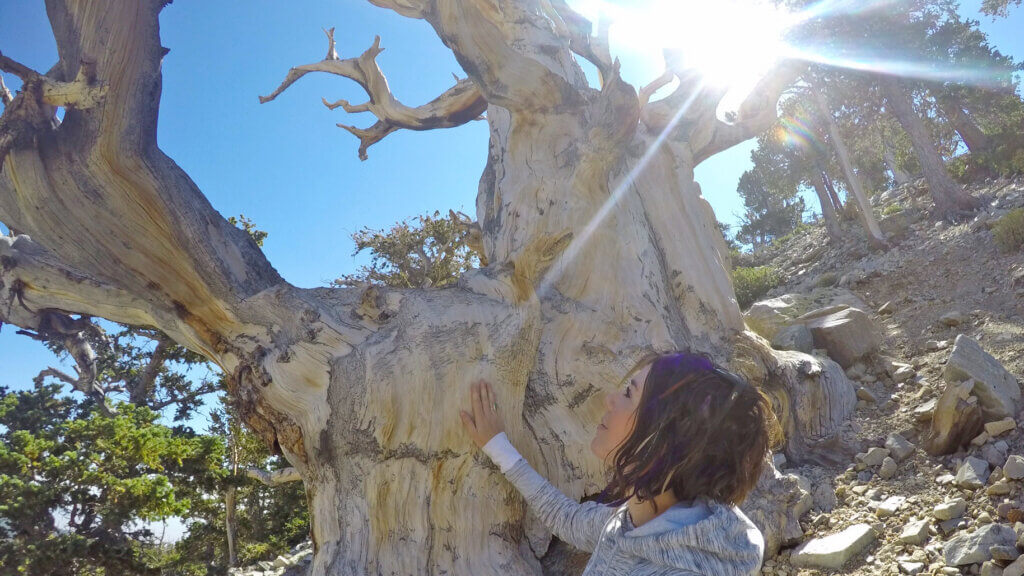
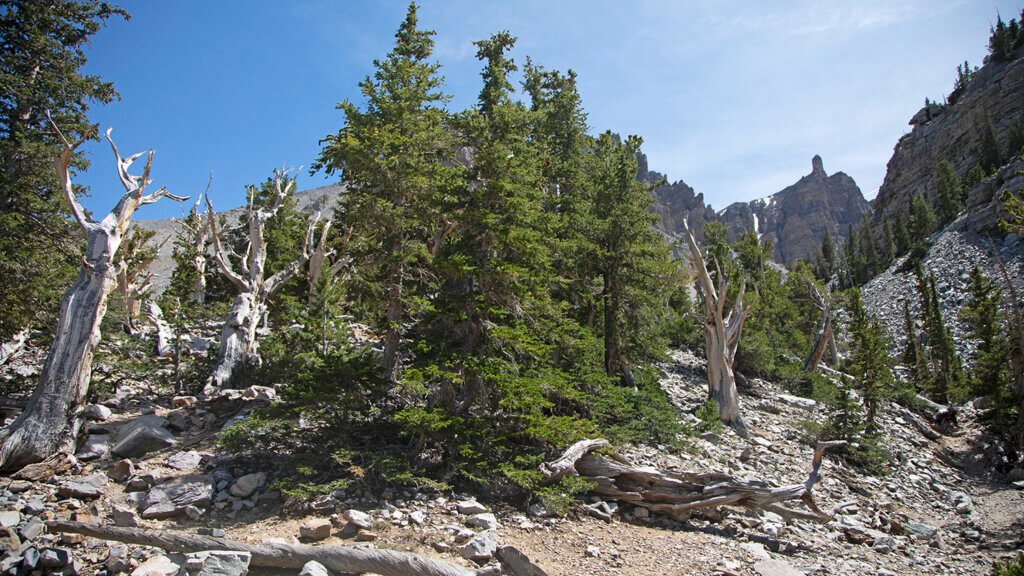
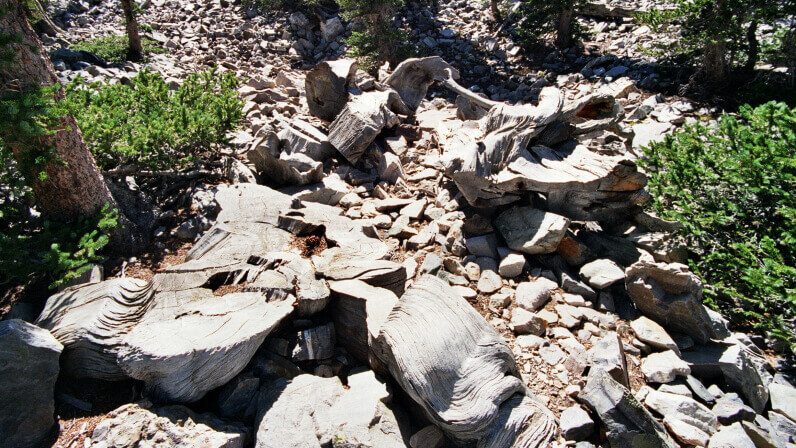
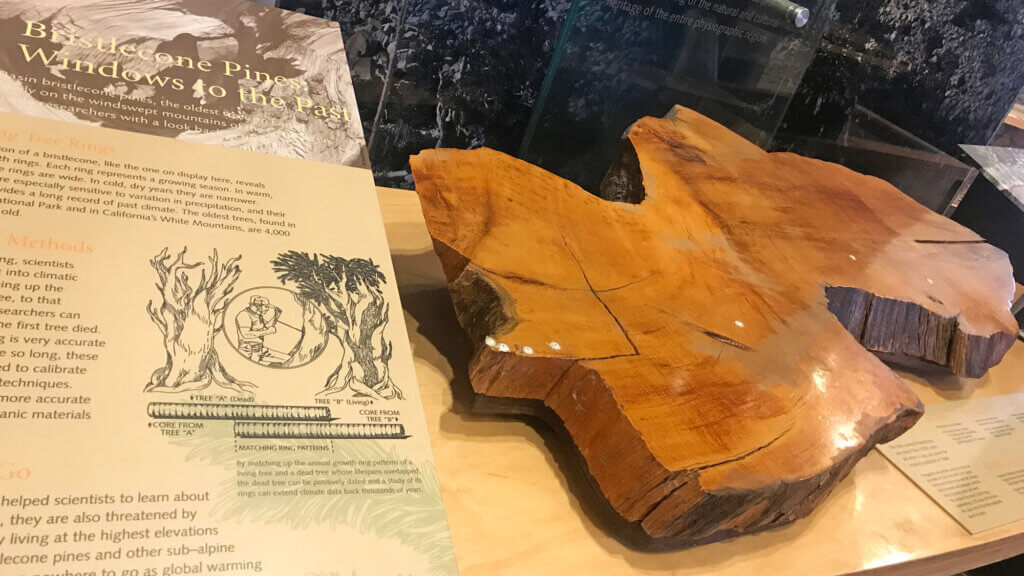
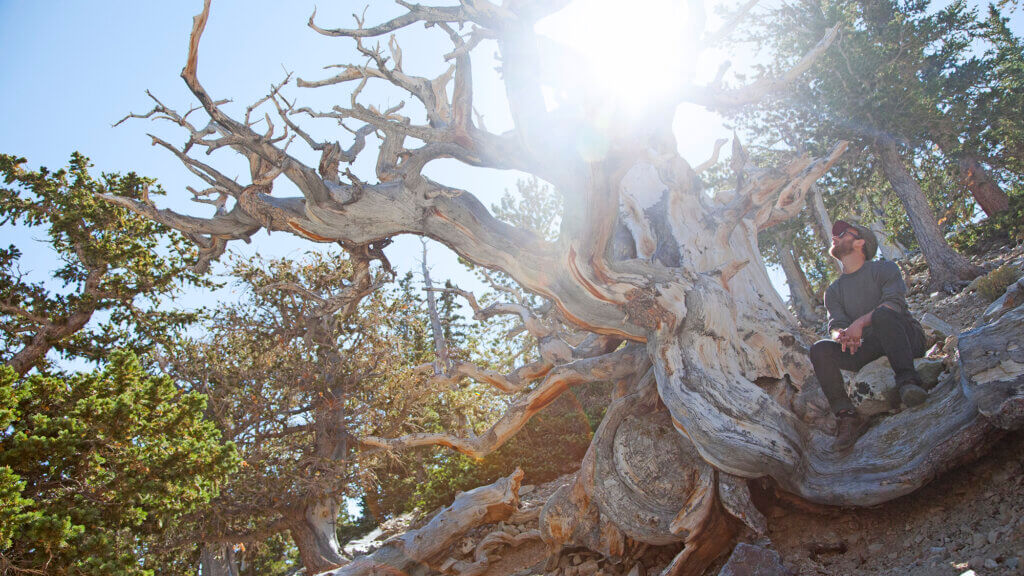
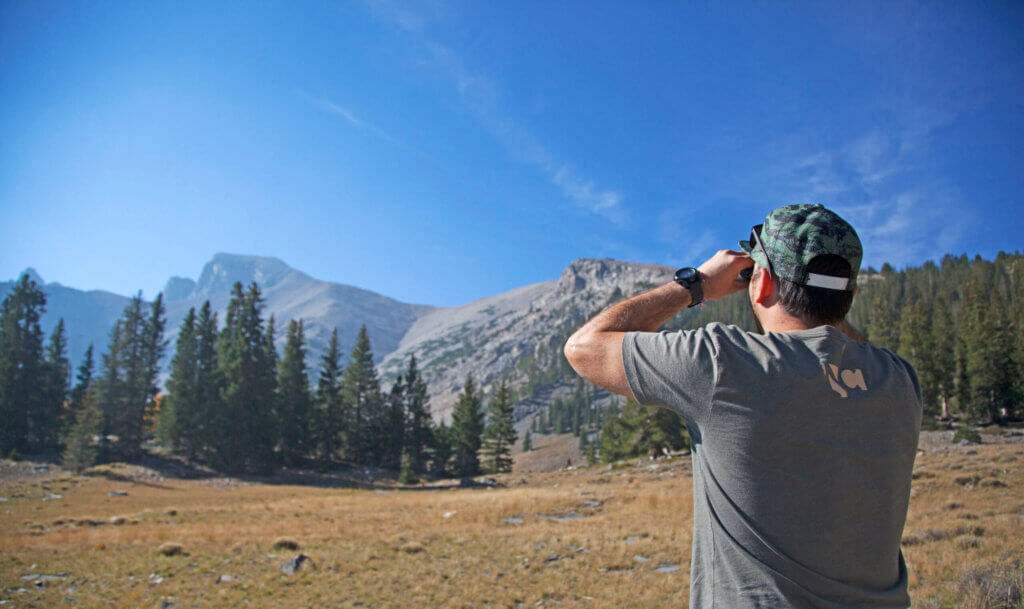
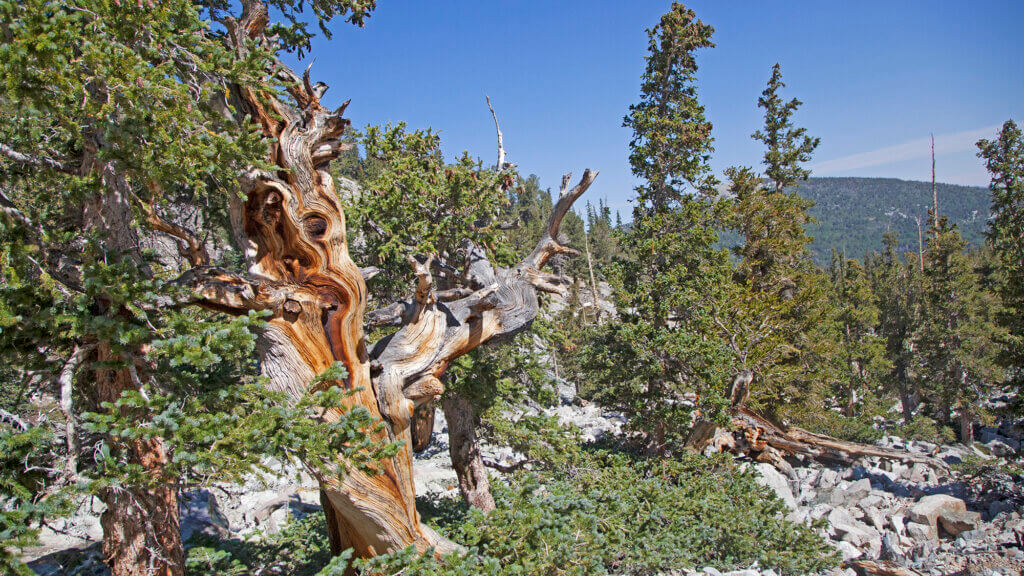
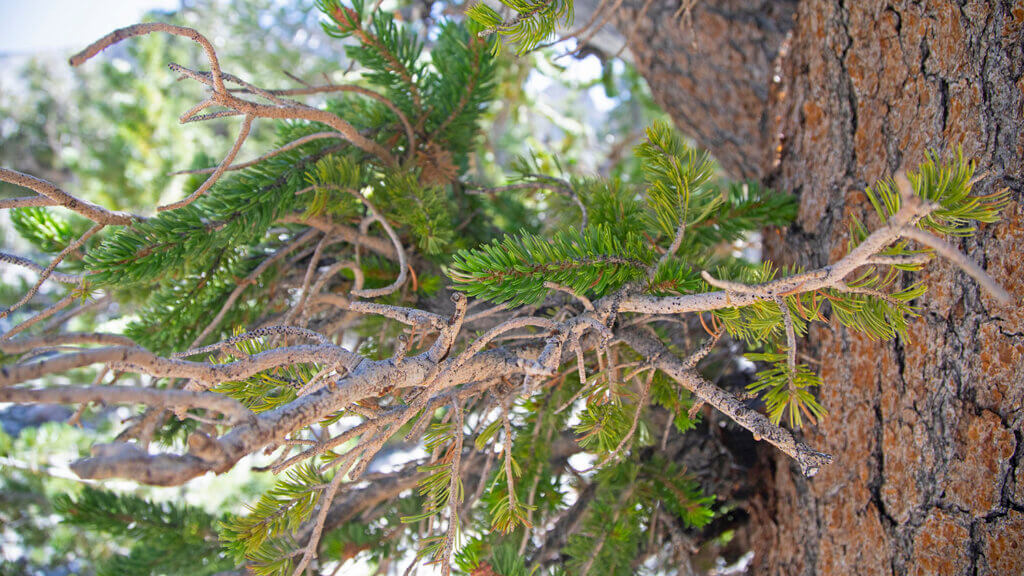
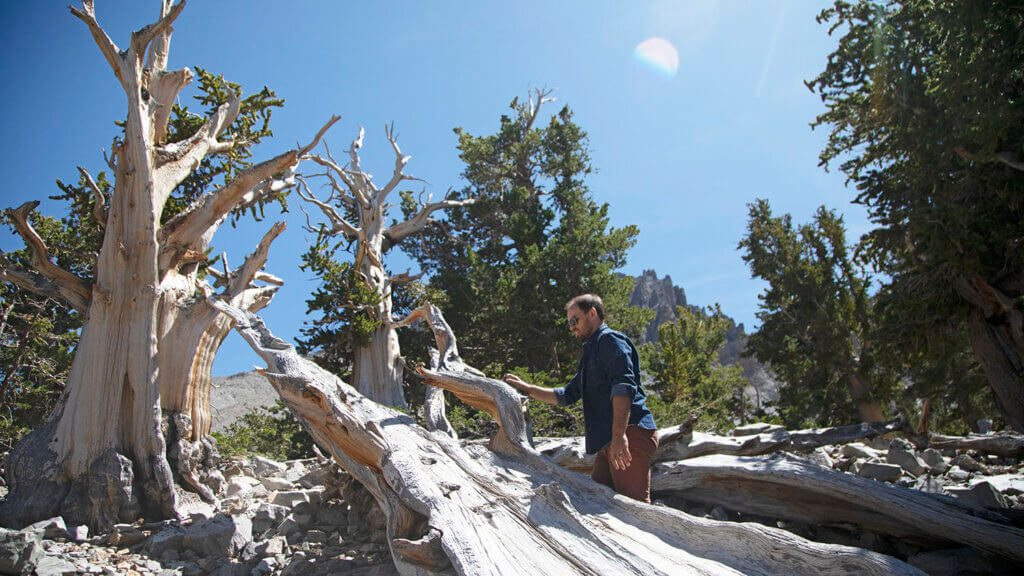
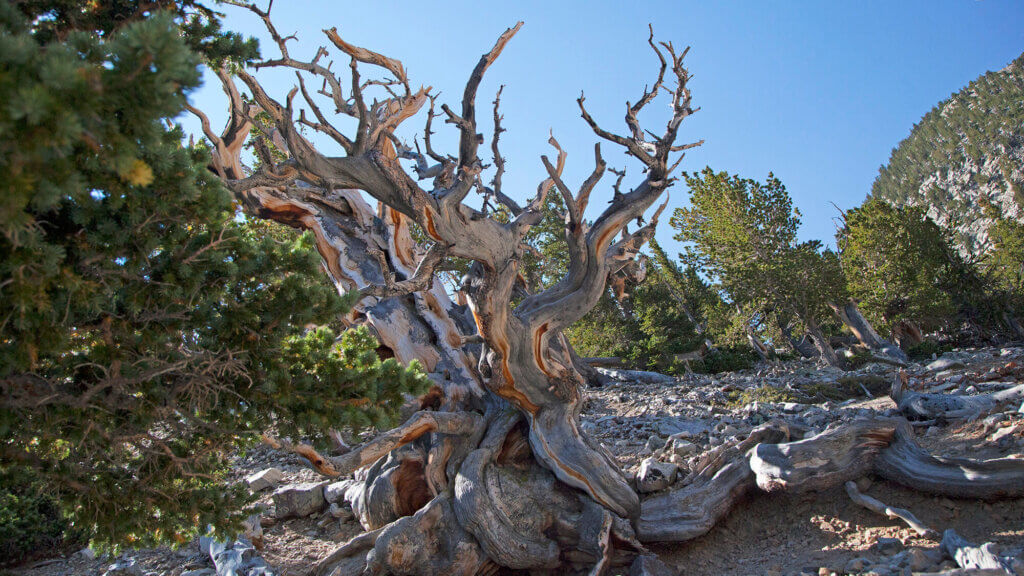
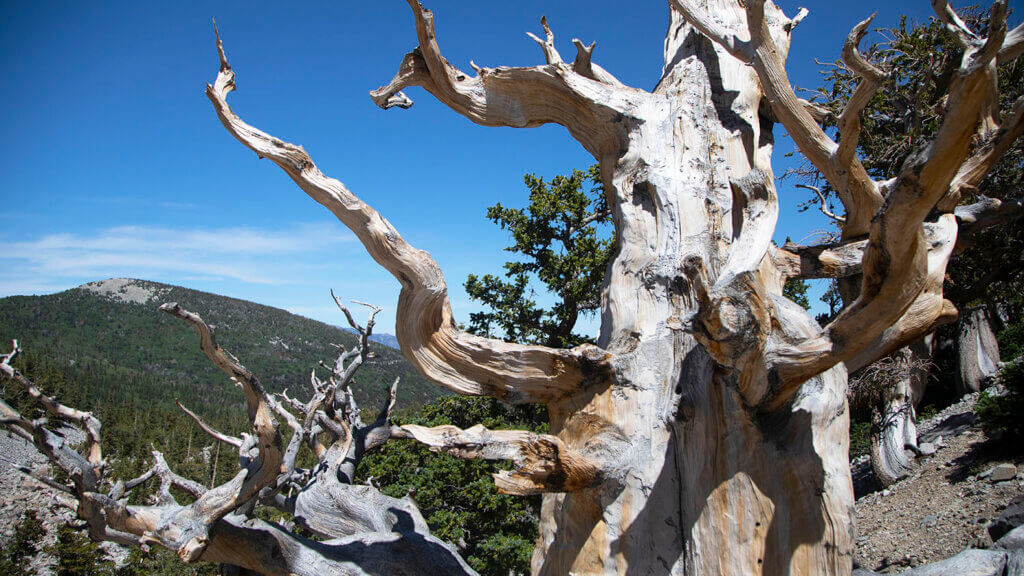
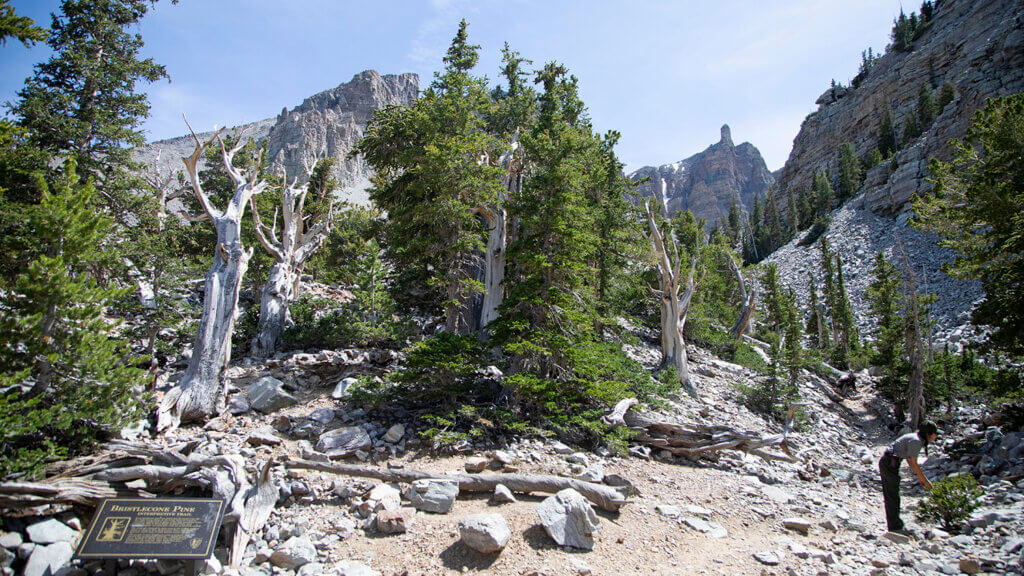
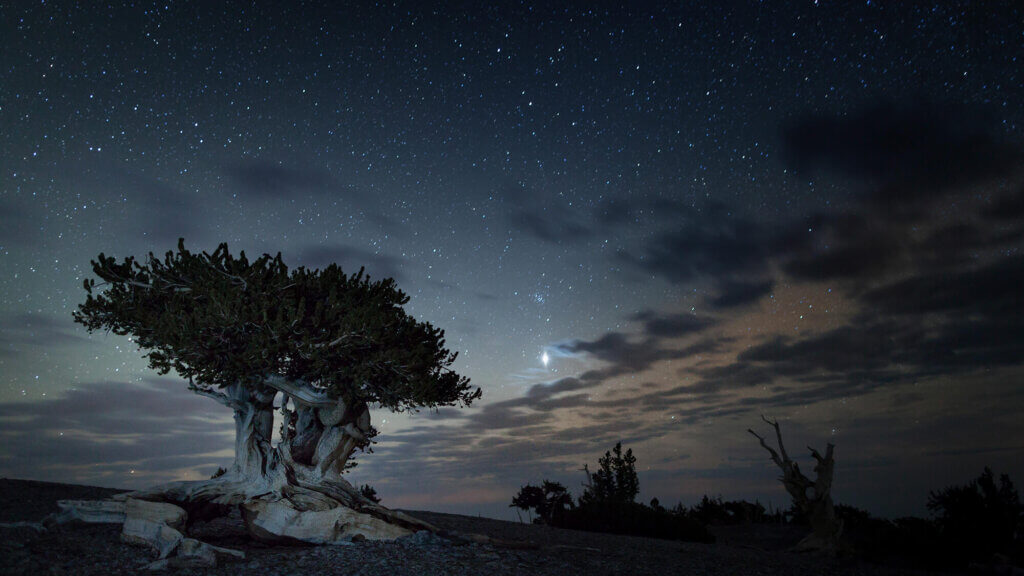
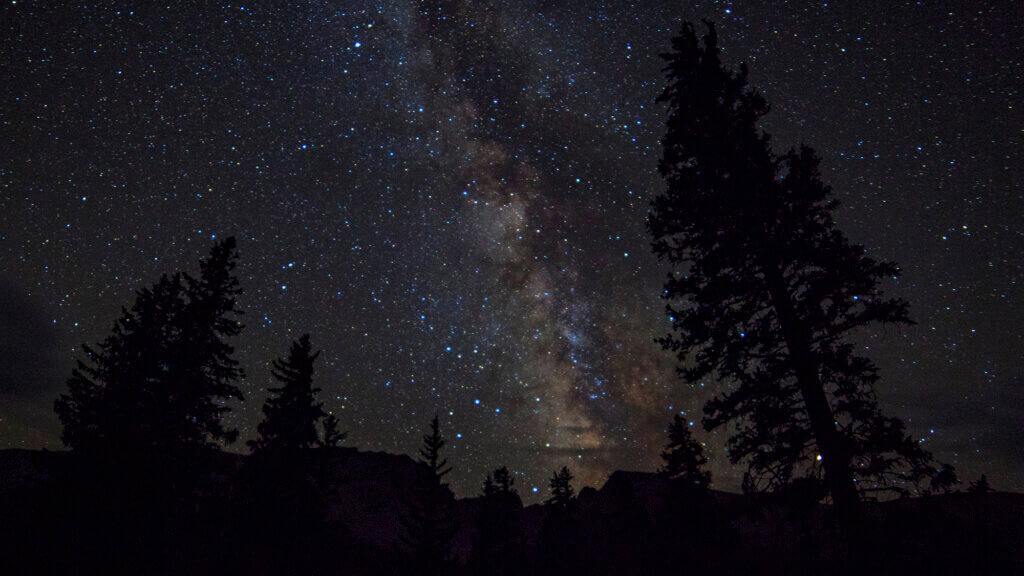
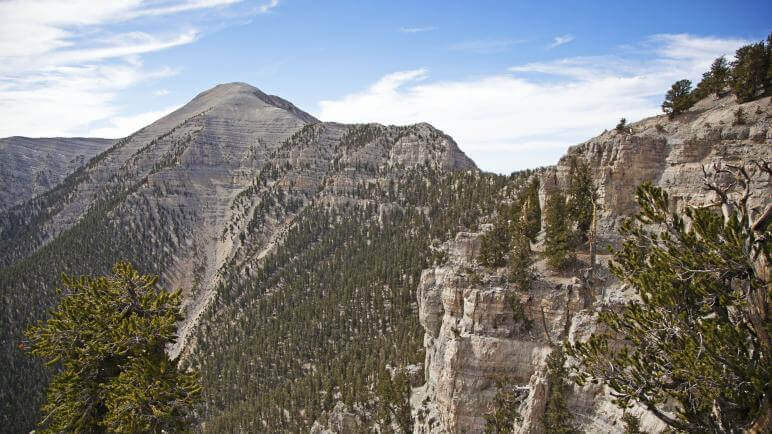
The Great Basin bristlecone pine: oldest living tree on Planet Earth.
Great Basin National Park was where we first discovered just how old these bad boys could be.
Great Basin National Park was where the ancient-ness of the bristlecone pine was originally discovered, with a specimen that was determined to be nearly 4,900 years old by a scientist studying Ice Age glaciology. (The park is home to Nevada’s last active glacier.) Later, up in the White Mountains—which straddle the Nevada-California border above Dyer, NV and Bishop, CA—another specimen was determined to be strapping 5,066 years old. That said, Nevada still gets to claim bragging rights for being the place where the groundbreaking study titled simply “The Bristlecone Pine is the Oldest Tree in the World” went down.
The Legend of Prometheus
There’s Prometheus the mythological Titan, who stole fire from Zeus and returned it to humankind, sparking our technological development. And then there’s Prometheus the bristlecone pine, which was already a mature tree when Hesiod first penned the early poem in the late 8th century BC.
In 1964, glaciologist Donald Currey came to Great Basin. In order to gain some traction in his Ice Age research, he was granted permission to take core samples from bristlecone pines, which are considered “climatic vaults” for the thousands of years of weather data “stored” within their rings.
Things went south when his instrument’s bit snapped off in a tree trunk and rangers allowed him to retrieve it by cutting the tree down. When they looked at its rings—all 4,862 of ’em—they suddenly realized they’d just simultaneously discovered and killed the oldest known tree on Earth. (In fact, since trees don’t form rings in exceptionally cold years, they then figured it was more like 4,900 years old.)
The tree was dubbed Prometheus, after the Titan—who just might’ve regretted returning that fire to us after all.
Great Basin National ParkGreat Basin National Park
You can meet Prometheus yourself
The fact that the world’s oldest tree was chopped down for the sake of science remains controversial to many. However, the truth is, without that study, we may never have even learned the incredible truth about bristlecone pines. (Some people actually assumed they were dead already.)
After Prometheus was hauled off the mountain, it was partitioned up to be studied further. Today, a slab of its trunk (which scientists call a “cookie”) can be found and appreciated in the Great Basin National Park Visitor Center.
Great Basin Visitor CenterSo what’s their secret? How have these ancient beauties survived all this time?
The bristlecone pine is exclusively found in high-altitude settings—where cold, harsh winters meet sunny, windy summers—with most groves finding their sweet spot starting at about 5,600 feet and extending all the way up to 11,200, often just at the edge of the tree line of other tree species.
In fact, the higher in elevation they live (and the meaner the weather they endure), the more their branches take on those iconically gnarled shapes. When they finally do die, instead of rotting like other trees, the exposed wood slowly weathers and seems to erode, twisting into unusual forms.
Great Basin National ParkMighty Wheeler Peak sets the perfect environmental stage
If you visit Great Basin National Park (best done during summer and fall), you can’t miss Wheeler Peak, scraping the sky at 13,065′ of elevation (Nevada’s 2nd-highest)—and towering 7,562′ above the high-desert steppes below. Looming over glimmering alpine lakes, glacial cirques, and some of the best camping and hiking in Nevada, Wheeler is actually the tallest peak in one of the most prominent mountain ranges in the most mountainous state in the Lower 48—as well as an ideal habitat for the bristlecone pine.
Wheeler PeakHow do you know a bristlecone when you see one?
The fact that the bristlecone appears to be dead (but isn’t) is amazing in itself. Many of these trees have some seriously sleek trunks that seem bare and bark-less, as if they’re some other kind of pine that’s been struck by lightening or simply lived a hollow existence for some time. Don’t be fooled; keep an eye out for tiny sprigs of bottle brush-looking plumes. Even if there’s just one tiny cluster at the very top, that thing is very much alive—and is a dead ringer for a living Great Basin bristlecone pine.
Great Basin National ParkWait, why is this pine called a “bristlecone pine?”
Like most coniferous trees, including of the pine variety, the bristlecone pine produces actual pine cones. Female cones sport extra prickly, scaly spikes, tipped with claw-like bristles. Bristle + cone… boom. Put that one in your back pocket for your next trivia night. (Maybe not literally, because ouch.) Either way, you’re welcome.
Great Basin National ParkLet’s get to the root of this thing
Many pines rely on a single tap root and utilize shallow just-below-the-surface roots to chase cracks in soil and sniff out water spots to send nutrients upward. Bristlecones do this, too; they just do it in a hardier way, in far tougher soil. Even after a lifetime of endurance, they can slowly start to shut off flow to outer limbs and hold on to the most viable living tissue, for centuries upon centuries, which is part of why they erode into the wild shapes they are known for—and can continue to, after they actually die.
Great Basin National ParkGrowing inch-by-inch, century-by-century
Yet another key to the bristlecone’s longevity is its slow-and-steady approach to growth, which you can chalk up to its environment’s combo of tough conditions—especially freezing temperatures, dry soils, high winds, and short growing seasons. Even the bristlecone’s clusters of needles can remain on the tree for a whopping 40 years (compared to 2 or 3 for most pines).
This slow growth rate also acts as a defense mechanism of sorts, as it makes the wood dense and heavy, which helps to ward off insects, fungi, rot, and weathering.
Great Basin National ParkA race against climate change
Although slow growth rate—a result of eons worth of adaptation—has been an asset to Great Basin bristlecones for dozens of thousands of years, it may not always be. Thanks to climate change, seasonal climactic factors have changed precipitously in the past 150 years; barely a moment to these ancient organisms, it is unlikely that they will learn to hurry their pace any time soon. Although scientists have yet to classify it beyond a low-level risk, close tabs are being kept to make sure the decline of grove populations isn’t speeding up before these trees can figure out what hit them.
Great Basin National ParkWhere can you see ancient bristlecones for yourself?
Great Basin National Park harbors multiple bristlecone pine groves. The most accessible is Bristlecone Grove, found on a moderately rated 2.8-mile round-trip hike from the incredible Wheeler Peak Campground. During the summer months, park rangers lead interpretive walks; however, any time that the trail is accessible, you’ll find signage to help discover just how special these trees are.
Meanwhile, Mount Washington Grove and Eagle Peak Grove offer vast clusters of these weathered beauties—both grand payoffs for intrepid hikers willing to take on steep, tricky terrain on unmaintained trails to view ancient beauties up to 40′ tall.
Great Basin National ParkAt Great Basin NP, “Half the Park is After Dark”
Great Basin National Park’s lack of light pollution is so renowned that, in 2016, DarkSky in 2016 designated it an International Dark Sky Park. It is home to one of the last true “dark sky environments” in the nation, which scientists consider an endangered resource.
This coveted darkness goes hand-in-hand with the brightness of the heavens—in which planets, complete constellations, the Milky Way, and even entire galaxies can be seen with the naked eye—as well as quietness. All of these are factors depended upon by a wide variety of wildlife, including the bristlecone pine.
Great Basin StargazingKelly Carroll/Great Basin National Park
Our Favorite Time to Visit
You really can’t go wrong any time the park isn’t snowbound (summer through fall). However, we’re big fans of September, when deciduous foliage (aspens are abundant here) is exploding with vibrancy and temperatures are in that magical sweet spot between not-too-hot days and not-too-chilly nights.
Best yet, in late September, the park hosts the free Great Basin Astronomy Festival, during which rangers and astro pros share their knowledge and massive, high-powered telescopes—which, after a day meandering among ancient trees that make you feel young, compounds it all with close-up looks at the universe that’ll make you feel small.
Great Basin Astronomy FestivalCan’t make it to Great Basin NP? Las Vegas to the rescue…
Great Basin National Park may be the best-known destination for bristlecone pine-spotting. However, in addition to groves found in neighboring ranges, the aforementioned White Mountains (where the oldest-known specimen resides), and a few places around Utah, the largest one on Earth is found (believe it or not) just outside the Entertainment Capital of the World. In the Spring Mountains, along the slopes of Mt. Charleston—Nevada’s most ultra-prominent peak—these gnarly ol’ guys are everywhere in sight throughout 18,000 acres of the wilderness area.
Spring Mountain National Recreation Area1/1
Get Inspired
Related Stories
